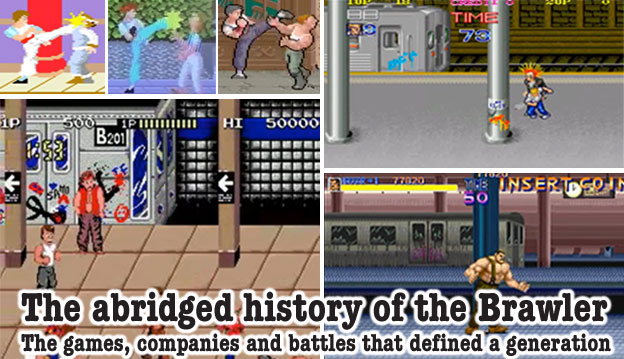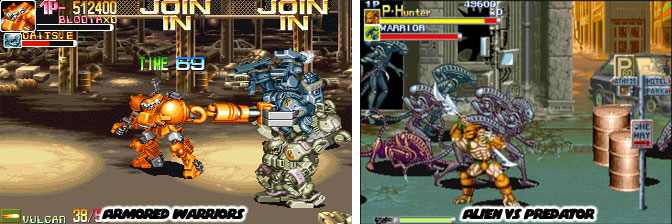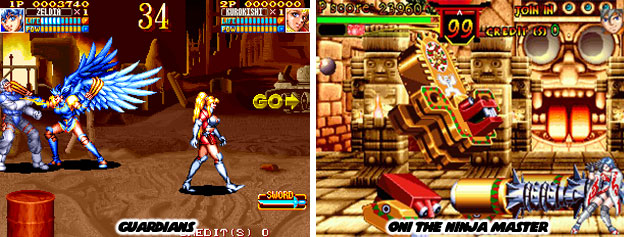
There was a steady decline in brawlers from 1992 through the rest of the decade. Most publishers were investing every available resource developing fighting games based on the success of Street Fighter. The studios that stuck around had to push even harder and try out new formulas to hold the attention of gamers. By this point Capcom was fully entrenched in both fighting and brawling titles. Having several of the artists and designers behind the Street Fighter franchise helped make sure their new brawlers would become hits.
Capcom started 1994 with another high profile license, this time stealing the spotlight from Konami. Alien vs Predator was inspired by the Dark Horse comic book series but did not take any particular plot points from it, instead trusting that they could craft a story that was as memorable as the comics or movies they were based on. The game was also a direct shot at the Aliens game that Konami had released a few years earlier.
The game was designed for 4-player action but most arcades had scaled back on the deluxe cabinet orders. Instead of four separate controls a regular 2-player JAMMA cabinet with the option for players to select characters was more often seen in arcades. Capcom relied on the designs from the legendary Bengus to help sell the game to audiences. He designed two Predators for the title, a Hunter and a Warrior He complimented them with two humans, Lieutenant Linn Kurosawa, a female android and a cybernetically enhanced Major Dutch Schafer. Dutch was the character that Arnold Schwarzenegger played in the original Predator movie. The vehicles, weapons, uniforms and even robots in the game were pulled from canon.

The game capitalized on everything that made the Capcom brawlers great, with the exception of the leveling system from Dungeons and Dragons. It had an intuitive fighting system, punches, kicks and grapples were supported. It also had a ranged attack system. All of the characters could shoot at Aliens and even rival Predators with ranged weapons. So that the game would not become dependent on simply gunning away the opponents there was a built in meter that tracked the ranged attacks. Characters had to wait for the weapons to either charge, reload or cool down when they overheated. This balance between shooting and brawling was very well done.
The stages and story in Alien vs Predator (AVP) unfolded into a complex narrative with betrayal from corporate and military factions, similar themes were used in the movies and comics. Even the ending was a perfect set up for a sequel that never came. If ever there were a perfect science fiction brawler then this game might have been it. The only competition it truly had in that arena was also released by Capcom.

The same year of AVP arcades saw Armored Warriors. It was a very unique take on the brawler where 25-foot tall robots instead of humans battled. Like AVP it was designed for a maximum of 4-players. Each robot had its own strengths and weakness, to give them personality the robots were shaped and colored differently plus the pilots could be seen during the cinema and text exchanges.
The game was set on a colonized planet that had the Earth pilots fighting the natives of Raia and their machines. The gameplay of fighting with a robot as compared to a human were subtle. The robots could cross the screen quickly on dash attacks plus they seemed to have weight and mass as they lumbered around the screen Human characters moved lightly in most brawlers. The robots could be upgraded to incorporate weapons into their combat throughout the game. No upgrade was better than a giant frame that the players could attach their robots to. The giant robot only lasted for about 20 seconds before it would have to return to base. It made the game too easy if players could summon it at a whim. This enormous robot was reminiscent of the classic anime shows, like Voltron, that inspired the development of the game.
Capcom had wrestled the brawling crown away from Konami and did not look back. In following years other studios would release games in hopes of earning a foothold in the market. Banpresto was one such studio and in 1995, a year that neither Capcom nor Konami had delivered a brawler, they kept the genre alive. Their biggest title of the year was a sequel actually Denjin Makai II, known as the Guardians everywhere else, was a sci-fi brawler with seven characters to play as including several species of aliens.
Each character had a set of regular and special attacks. The special attacks were often ranged and depended on a separate meter, similar to AVP gun mechanic. However players could hold a few buttons and charge up the bar manually to replenish the special strikes. A similar charging mechanic had been used by SNK with their fighting games years earlier. It was a fun brawler filled with interesting details and locations, elements that made the futuristic alien world seem alive.

Banpresto’s next title for 1995 kept the exotic designs but changed up the gameplay. Oni the Ninja Master / Metamoqester, Was a two-player fighting adventure, similar to Konami’s Monster Maulers from a few years prior.
The game had some fun designs as it took players around the world challenging all sorts of giant monsters. The most memorable thing for me and what I believe to be the biggest contribution from the game was the use of 3D modeling in the levels and some of the bosses. Everything in the game was sprite-based however some of the bosses and level effects were modeled from CGI shapes, lending a certain level of precision with the objects and animations in the game that would have been impossible to do by hand. Many gamers had first seen the use of CGI models as the basis for sprites in the 1994 in the games Killer Instinct and Donkey Kong Country, both developed by Rare. Banpresto kept the anime-style colors and designs so that they maintained the fluidity of traditional game animation. The seeds for using CGI backgrounds over sprite-based combat were not planted by SNK or Capcom in their VS games as many would believe, they began with Metamoqester. The 3D technology provided by working with polygons was changing the landscape of both arcade and console gaming, the days of the sprite-based brawler were coming to an end. In the next entry we will look at the fantastic send off that Capcom and an independent studio gave the genre. As always if you enjoyed this blog and would like to sponsor me please visit my Patreon page and consider donating each month, even as little as $1 would help make better blogs and even podcasts!

Finally, let's start with my favorite brawler-era! AVP and Armored Warriors are among my favorite brawlers of all time.
ReplyDeletezero, this was an amazing time for brawlers. It's a shame that Capcom doesn't revisit the legacy they started.
DeleteYep, so much potential, so many great characters (some also used in fighting games as Cyberbots).
DeleteThanks God, we can play them emulated, I play almost regularly AVP, I think it's a masterpiece.
I'll never thank enough the guys who have emulated the CPS3, otherwise I would never been able to try that jewel of Warzard...if I remember well its characters inserted in Capcom Fighting Jam had many cut frames (beside that, the game was totally different so it does not count anyway).